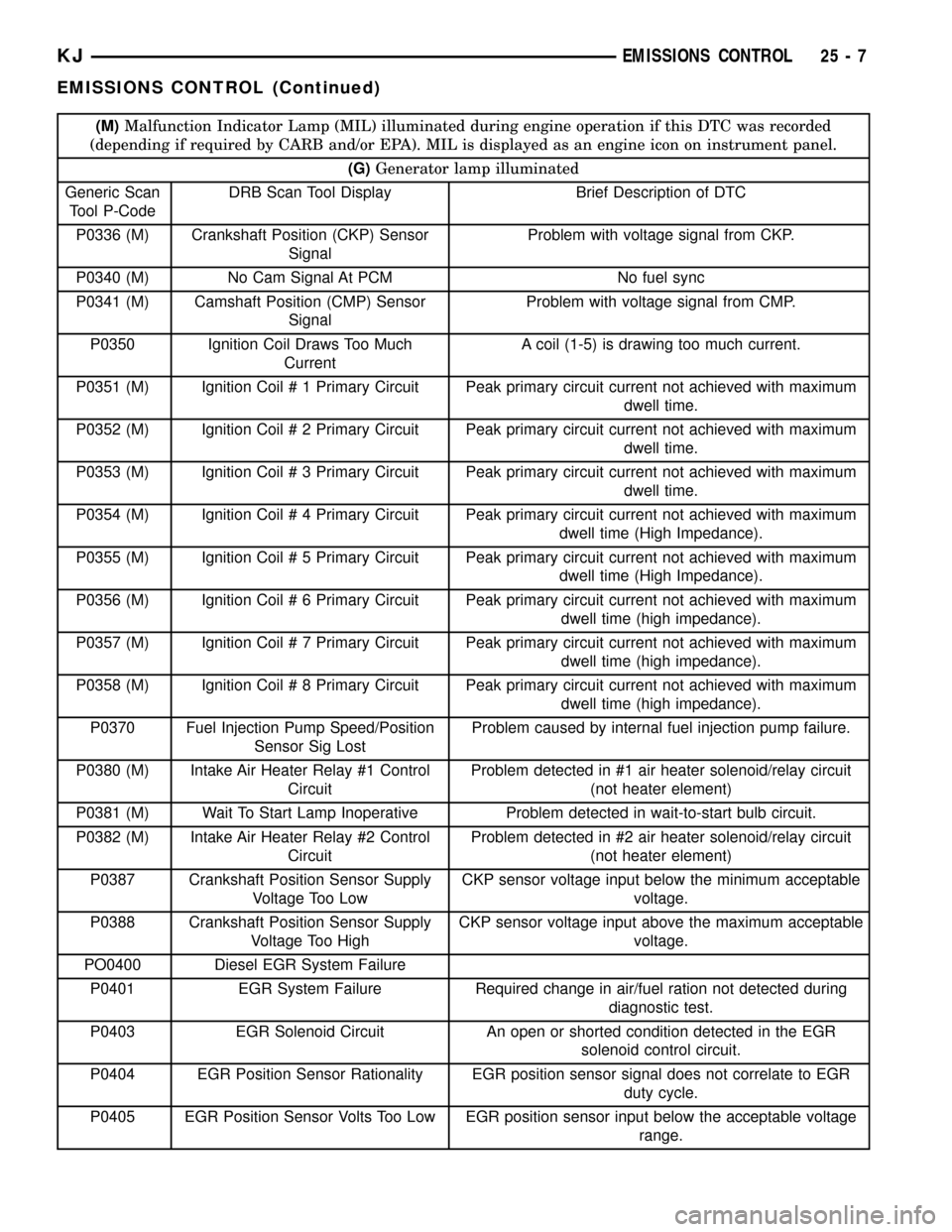2002 JEEP LIBERTY Ignition coil
[x] Cancel search: Ignition coilPage 1425 of 1803

WARNING: THE EXHAUST MANIFOLD, EXHAUST
PIPES AND CATALYTIC CONVERTER BECOME
VERY HOT DURING ENGINE OPERATION. ALLOW
ENGINE TO COOL BEFORE REMOVING OXYGEN
SENSOR.
(1) Raise and support vehicle.
(2) Disconnect wire connector from O2S sensor.
CAUTION: When disconnecting sensor electrical
connector, do not pull directly on wire going into
sensor.
(3) Remove O2S sensor with an oxygen sensor
removal and installation tool.
(4) Clean threads in exhaust pipe using appropri-
ate tap.
INSTALLATION
Threads of new oxygen sensors are factory coated
with anti-seize compound to aid in removal.DO
NOT add any additional anti-seize compound to
threads of a new oxygen sensor.
(1) Install O2S sensor. Tighten to 30 N´m (22 ft.
lbs.) torque.
(2) Connect O2S sensor wire connector.
(3) Lower vehicle.
THROTTLE BODY
DESCRIPTION
The throttle body is located on the intake manifold.
Fuel does not enter the intake manifold through the
throttle body. Fuel is sprayed into the manifold by
the fuel injectors.
OPERATION
Filtered air from the air cleaner enters the intake
manifold through the throttle body. The throttle body
contains an air control passage controlled by an Idle
Air Control (IAC) motor. The air control passage is
used to supply air for idle conditions. A throttle valve
(plate) is used to supply air for above idle conditions.
Certain sensors are attached to the throttle body.
The accelerator pedal cable, speed control cable and
transmission control cable (when equipped) are con-
nected to the throttle body linkage arm.
A (factory adjusted) set screw is used to mechani-
cally limit the position of the throttle body throttle
plate.Never attempt to adjust the engine idle
speed using this screw.All idle speed functions are
controlled by the PCM.
REMOVAL
2.4L
A (factory adjusted) set screw is used to mechani-
cally limit the position of the throttle body throttle
plate.Never attempt to adjust the engine idle
speed using this screw.All idle speed functions are
controlled by the Powertrain Control Module (PCM).
(1) Remove air cleaner tube at throttle body.
(2) Disconnect throttle body electrical connectors
at IAC motor and TPS.
(3) Remove all control cables from throttle body
(lever) arm. Refer to the Accelerator Pedal and Throt-
tle Cable section for removal/installation procedures.
(4) Disconnect necessary vacuum lines at throttle
body.
(5) Remove 3 throttle body mounting bolts (Fig.
23).
(6) Remove throttle body from intake manifold.
(7) Check condition of old throttle body-to-intake
manifold o-ring.
3.7L
A (factory adjusted) set screw is used to mechani-
cally limit the position of the throttle body throttle
plate.Never attempt to adjust the engine idle
speed using this screw.All idle speed functions are
controlled by the Powertrain Control Module (PCM).
(1) Remove air cleaner tube at throttle body.
(2) Disconnect throttle body electrical connectors
at IAC motor and TPS.
Fig. 23 THROTTLE BODY MOUNTING BOLTS - 2.4L
1 - THROTTLE BODY
2 - IGNITION COIL
3 - MOUNTING BOLTS (3)
KJFUEL INJECTION 14 - 43
OXYGEN SENSOR (Continued)
Page 1668 of 1803

(2) Resistance between terminals 85 and 86 (elec-
tromagnet) should be 67.5 to 82.5 ohms. If OK, go to
Step 3. If not OK, replace the faulty relay.
(3) Connect a battery to terminals 85 and 86.
There should now be continuity between terminals
30 and 87, and no continuity between terminals 87A
and 30. If OK, see Relay Circuit Test. If not OK,
replace the faulty relay.
RELAY CIRCUIT TEST
For circuit descriptions and diagrams, (Refer to
Appropriate Wiring Information).
(1) The relay common feed terminal cavity (30) is
connected to fused battery feed. There should be bat-
tery voltage at the cavity for relay terminal 30 at all
times. If OK, go to Step 2. If not OK, repair the open
circuit to the fuse in the PDC as required.
(2) The relay normally closed terminal (87A) is not
used in this application. Go to Step 3.
(3) The relay normally open terminal cavity (87) is
connected to the compressor clutch coil. There should
be continuity between this cavity and the A/C com-
pressor clutch relay output circuit cavity of the com-
pressor clutch coil wire harness connector. If OK, go
to Step 4. If not OK, repair the open circuit as
required.
(4) The relay coil battery terminal (86) is con-
nected to the fused ignition switch output (run/start)circuit. There should be battery voltage at the cavity
for relay terminal 86 with the ignition switch in the
On position. If OK, go to Step 5. If not OK, repair the
open circuit to the fuse in the junction block as
required.
(5) The coil ground terminal cavity (85) is switched
to ground through the Powertrain Control Module
(PCM). There should be continuity between this cav-
ity and the A/C compressor clutch relay control cir-
cuit cavity of the PCM wire harness connector C
(gray) at all times. If not OK, repair the open circuit
as required.
REMOVAL
(1) Disconnect and isolate the battery negative
cable.
(2) Remove the cover from the Power Distribution
Center (PDC).
(3) Refer to the label on the PDC for compressor
clutch relay identification and location.
(4) Unplug the compressor clutch relay from the
PDC.
INSTALLATION
(1) Install the compressor clutch relay by aligning
the relay terminals with the cavities in the PDC and
pushing the relay firmly into place.
(2) Install the PDC cover.
(3) Connect the battery negative cable.
(4) Test the relay operation.
A/C HEATER CONTROL
DESCRIPTION
Both the heater-only and A/C heater systems use a
combination of mechanical, electrical, and vacuum
controls. These controls provide the vehicle operator
with a number of setting options to help control the
climate and comfort within the vehicle. Refer to the
owner's manual in the vehicle glove box for more
information on the features, use, and suggested oper-
ation of these controls.
The heater-only or A/C heater control panel is
located to the right of the instrument cluster on the
instrument panel. The control panel contains a rota-
ry-type temperature control knob, a rotary-type mode
control switch knob, and a rotary-type blower motor
speed switch knob. The control also has a push but-
ton to activate the rear window defogger.
The heater-only or A/C heater control panel cannot
be repaired. If faulty or damaged, the entire unit
must be replaced. The illumination lamps are avail-
able for service replacement.
Fig. 10 COMPRESSOR CLUTCH RELAY
30 - COMMON FEED
85 - COIL GROUND
86 - COIL BATTERY
87 - NORMALLY OPEN
87A - NORMALLY CLOSED
24 - 16 CONTROLSKJ
A/C COMPRESSOR CLUTCH RELAY (Continued)
Page 1672 of 1803

(2) Install and tighten the a/c low pressure switch
on the accumulator fitting. The switch should be
hand-tightened onto the accumulator fitting.
(3) Plug the wire harness connector into the a/c
low pressure switch.
(4) Connect the battery negative cable.
BLEND DOOR ACTUATOR
REMOVAL
WARNING: ON VEHICLES EQUIPPED WITH AIR-
BAGS, DISABLE THE AIRBAG SYSTEM BEFORE
ATTEMPTING ANY STEERING WHEEL, STEERING
COLUMN, OR INSTRUMENT PANEL COMPONENT
DIAGNOSIS OR SERVICE. DISCONNECT AND ISO-
LATE THE BATTERY NEGATIVE (GROUND) CABLE,
THEN WAIT TWO MINUTES FOR THE AIRBAG SYS-
TEM CAPACITOR TO DISCHARGE BEFORE PER-
FORMING FURTHER DIAGNOSIS OR SERVICE. THIS
IS THE ONLY SURE WAY TO DISABLE THE AIRBAG
SYSTEM. FAILURE TO TAKE THE PROPER PRE-
CAUTIONS COULD RESULT IN AN ACCIDENTAL
AIRBAG DEPLOYMENT AND POSSIBLE PERSONAL
INJURY.
(1) Disconnect and isolate the battery negative
cable.
(2) Remove A/C housing from vehicle(Refer to 24 -
HEATING & AIR CONDITIONING/DISTRIBUTION/
HVAC HOUSING - REMOVAL).
(3) Remove the screws that secure the blend door
actuator to the top of the HVAC housing. (Fig. 14).
(4) Remove the blend door actuator.
INSTALLATION
(1) Install the blend door actuator in place.
(2) Install and tighten the screws that secure the
blend door actuator to the housing. Tighten the
mounting screws to 2.4 ( .34) N´m (21 ( 3) in. lbs.).
(3) Install the HVAC housing into the vehicle(Re-
fer to 24 - HEATING & AIR CONDITIONING/DIS-
TRIBUTION/HVAC HOUSING - INSTALLATION).
(4) Install the blend door actuator electrical con-
nector from the wiring harness through the glove
box.
(5) Connect the battery negative cable.
BLOWER MOTOR RELAY
DESCRIPTION
The blower motor relay is a International Stan-
dards Organization (ISO)-type relay. The relay is a
electromechanical device that switches battery cur-
rent from a fuse in the Power Distribution Center
(PDC) directly to the blower motor. The relay is ener-
gized when the relay coil is provided a voltage signal
by the ignition switch. (Refer to 24 - HEATING &
AIR CONDITIONING/CONTROLS/BLOWER
MOTOR RELAY - DIAGNOSIS AND TESTING)
OPERATION
The blower motor relay is installed in a wire har-
ness connector that is secured to the passenger side
outboard end of the HVAC housing in the passenger
compartment, next to the HVAC wire harness con-
nector.
The blower motor relay cannot be repaired and, if
faulty or damaged, it must be replaced.
Fig. 14 HEATER CORE REMOVAL/INSTALLATION
1 - HEATER CORE
2- MOUNTING SCREW HOLE
3- INLET AND OUTLET TUBES
4- VACUUM HARNESS
5- ACTUATOR SCREWS (3)
6- ELECTRIC BLEND DOOR ACTUATOR
7- MOUNTING SCREW HOLE
8- HEATER CORE RETAINER TABS (4)
24 - 20 CONTROLSKJ
A/C LOW PRESSURE SWITCH (Continued)
Page 1673 of 1803

DIAGNOSIS AND TESTING - BLOWER MOTOR
RELAY
WARNING: ON VEHICLES EQUIPPED WITH AIR-
BAGS, DISABLE THE AIRBAG SYSTEM BEFORE
ATTEMPTING ANY STEERING WHEEL, STEERING
COLUMN, OR INSTRUMENT PANEL COMPONENT
DIAGNOSIS OR SERVICE. DISCONNECT AND ISO-
LATE THE BATTERY NEGATIVE (GROUND) CABLE,
THEN WAIT TWO MINUTES FOR THE AIRBAG SYS-
TEM CAPACITOR TO DISCHARGE BEFORE PER-
FORMING FURTHER DIAGNOSIS OR SERVICE. THIS
IS THE ONLY SURE WAY TO DISABLE THE AIRBAG
SYSTEM. FAILURE TO TAKE THE PROPER PRE-
CAUTIONS COULD RESULT IN AN ACCIDENTAL
AIRBAG DEPLOYMENT AND POSSIBLE PERSONAL
INJURY.
RELAY TEST
The blower motor relay (Fig. 15) is located in the
PDC which is located under the hood.. Remove the
relay from the PDC to perform the following tests:
(1) A relay in the de-energized position should
have continuity between terminals 87A and 30, and
no continuity between terminals 87 and 30. If OK, go
to Step 2. If not OK, replace the faulty relay.
(2) Resistance between terminals 85 and 86 (elec-
tromagnet) should be 60.7 to 80.3 ohms. If OK, go to
Step 3. If not OK, replace the faulty relay.
(3) Connect a battery to terminals 85 and 86.
There should now be continuity between terminals
30 and 87, and no continuity between terminals 87A
and 30. If OK, see the Relay Circuit Test. If not OK,
replace the faulty relay.
RELAY CIRCUIT TEST
For circuit descriptions and diagrams, (Refer to
Appropriate Wiring Information).
(1) The relay common feed terminal cavity (30) is
connected to fused battery feed directly from a fuse
in the Power Distribution Center (PDC), and should
be hot at all times. Check for battery voltage at the
connector cavity for relay terminal 30. If OK, go to
Step 2. If not OK, repair the open circuit to the PDC
fuse as required.
(2) The relay normally closed terminal cavity (87A)
is not used for this application. Go to Step 3.
(3) The relay normally open terminal cavity (87) is
connected to the blower motor. When the relay is
energized, terminal 87 is connected to terminal 30
and provides full battery current to the blower motor
feed circuit. There should be continuity between the
connector cavity for terminal 87 and the blower
motor at all times. If OK, go to Step 4. If not OK,
repair the open circuit to the blower motor as
required.
(4) The coil battery terminal cavity (86) is con-
nected to the ignition switch. When the ignition
switch is placed in the On position, fused ignition
switch output is directed from a fuse in the junction
block to the relay electromagnetic coil to energize the
relay. There should be battery voltage at the connec-
tor cavity for relay terminal 86 with the ignition
switch in the On position. If OK, go to Step 5. If not
OK, repair the open circuit to the junction block fuse
as required.
(5) The coil ground terminal cavity (85) is con-
nected to ground. This terminal supplies the ground
for the relay electromagnet coil. There should be con-
tinuity between the connector cavity for relay termi-
nal 85 and a good ground at all times. If not OK,
repair the open circuit as required.
REMOVAL
WARNING: ON VEHICLES EQUIPPED WITH AIR-
BAGS, DISABLE THE AIRBAG SYSTEM BEFORE
ATTEMPTING ANY STEERING WHEEL, STEERING
COLUMN, OR INSTRUMENT PANEL COMPONENT
DIAGNOSIS OR SERVICE. DISCONNECT AND ISO-
LATE THE BATTERY NEGATIVE (GROUND) CABLE,
THEN WAIT TWO MINUTES FOR THE AIRBAG SYS-
TEM CAPACITOR TO DISCHARGE BEFORE PER-
FORMING FURTHER DIAGNOSIS OR SERVICE. THIS
IS THE ONLY SURE WAY TO DISABLE THE AIRBAG
SYSTEM. FAILURE TO TAKE THE PROPER PRE-
CAUTIONS COULD RESULT IN AN ACCIDENTAL
AIRBAG DEPLOYMENT AND POSSIBLE PERSONAL
INJURY.
Fig. 15 BLOWER MOTOR RELAY
30 - COMMON FEED
85 - COIL GROUND
86 - COIL BATTERY
87 - NORMALLY OPEN
87A - NORMALLY CLOSED
KJCONTROLS 24 - 21
BLOWER MOTOR RELAY (Continued)
Page 1713 of 1803

(M)Malfunction Indicator Lamp (MIL) illuminated during engine operation if this DTC was recorded
(depending if required by CARB and/or EPA). MIL is displayed as an engine icon on instrument panel.
(G)Generator lamp illuminated
Generic Scan
Tool P-CodeDRB Scan Tool Display Brief Description of DTC
P0336 (M) Crankshaft Position (CKP) Sensor
SignalProblem with voltage signal from CKP.
P0340 (M) No Cam Signal At PCM No fuel sync
P0341 (M) Camshaft Position (CMP) Sensor
SignalProblem with voltage signal from CMP.
P0350 Ignition Coil Draws Too Much
CurrentA coil (1-5) is drawing too much current.
P0351 (M) Ignition Coil # 1 Primary Circuit Peak primary circuit current not achieved with maximum
dwell time.
P0352 (M) Ignition Coil # 2 Primary Circuit Peak primary circuit current not achieved with maximum
dwell time.
P0353 (M) Ignition Coil # 3 Primary Circuit Peak primary circuit current not achieved with maximum
dwell time.
P0354 (M) Ignition Coil # 4 Primary Circuit Peak primary circuit current not achieved with maximum
dwell time (High Impedance).
P0355 (M) Ignition Coil # 5 Primary Circuit Peak primary circuit current not achieved with maximum
dwell time (High Impedance).
P0356 (M) Ignition Coil # 6 Primary Circuit Peak primary circuit current not achieved with maximum
dwell time (high impedance).
P0357 (M) Ignition Coil # 7 Primary Circuit Peak primary circuit current not achieved with maximum
dwell time (high impedance).
P0358 (M) Ignition Coil # 8 Primary Circuit Peak primary circuit current not achieved with maximum
dwell time (high impedance).
P0370 Fuel Injection Pump Speed/Position
Sensor Sig LostProblem caused by internal fuel injection pump failure.
P0380 (M) Intake Air Heater Relay #1 Control
CircuitProblem detected in #1 air heater solenoid/relay circuit
(not heater element)
P0381 (M) Wait To Start Lamp Inoperative Problem detected in wait-to-start bulb circuit.
P0382 (M) Intake Air Heater Relay #2 Control
CircuitProblem detected in #2 air heater solenoid/relay circuit
(not heater element)
P0387 Crankshaft Position Sensor Supply
Voltage Too LowCKP sensor voltage input below the minimum acceptable
voltage.
P0388 Crankshaft Position Sensor Supply
Voltage Too HighCKP sensor voltage input above the maximum acceptable
voltage.
PO0400 Diesel EGR System Failure
P0401 EGR System Failure Required change in air/fuel ration not detected during
diagnostic test.
P0403 EGR Solenoid Circuit An open or shorted condition detected in the EGR
solenoid control circuit.
P0404 EGR Position Sensor Rationality EGR position sensor signal does not correlate to EGR
duty cycle.
P0405 EGR Position Sensor Volts Too Low EGR position sensor input below the acceptable voltage
range.
KJEMISSIONS CONTROL 25 - 7
EMISSIONS CONTROL (Continued)
Page 1726 of 1803

an associated limp in will take two trips to illumi-
nate the MIL.
Refer to the Diagnostic Trouble Codes Description
Charts in this section and the appropriate Power-
train Diagnostic Procedure Manual for diagnostic
procedures.
DESCRIPTION - NON-MONITORED CIRCUITS
The PCM does not monitor the following circuits,
systems and conditions that could have malfunctions
causing driveability problems. The PCM might not
store diagnostic trouble codes for these conditions.
However, problems with these systems may cause the
PCM to store diagnostic trouble codes for other sys-
tems or components. For example, a fuel pressure
problem will not register a fault directly, but could
cause a rich/lean condition or misfire. This could
cause the PCM to store an oxygen sensor or misfire
diagnostic trouble code
FUEL PRESSURE
The fuel pressure regulator controls fuel system
pressure. The PCM cannot detect a clogged fuel
pump inlet filter, clogged in-line fuel filter, or a
pinched fuel supply or return line. However, these
could result in a rich or lean condition causing the
PCM to store an oxygen sensor or fuel system diag-
nostic trouble code.
SECONDARY IGNITION CIRCUIT
The PCM cannot detect an inoperative ignition coil,
fouled or worn spark plugs, ignition cross firing, or
open spark plug cables.
CYLINDER COMPRESSION
The PCM cannot detect uneven, low, or high engine
cylinder compression.
EXHAUST SYSTEM
The PCM cannot detect a plugged, restricted or
leaking exhaust system, although it may set a fuel
system fault.
FUEL INJECTOR MECHANICAL MALFUNCTIONS
The PCM cannot determine if a fuel injector is
clogged, the needle is sticking or if the wrong injectoris installed. However, these could result in a rich or
lean condition causing the PCM to store a diagnostic
trouble code for either misfire, an oxygen sensor, or
the fuel system.
EXCESSIVE OIL CONSUMPTION
Although the PCM monitors engine exhaust oxygen
content when the system is in closed loop, it cannot
determine excessive oil consumption.
THROTTLE BODY AIRFLOW
The PCM cannot detect a clogged or restricted air
cleaner inlet or filter element.
VACUUM ASSIST
The PCM cannot detect leaks or restrictions in the
vacuum circuits of vacuum assisted engine control
system devices. However, these could cause the PCM
to store a MAP sensor diagnostic trouble code and
cause a high idle condition.
PCM SYSTEM GROUND
The PCM cannot determine a poor system ground.
However, one or more diagnostic trouble codes may
be generated as a result of this condition. The mod-
ule should be mounted to the body at all times, also
during diagnostic.
PCM CONNECTOR ENGAGEMENT
The PCM may not be able to determine spread or
damaged connector pins. However, it might store
diagnostic trouble codes as a result of spread connec-
tor pins.
DESCRIPTION - HIGH AND LOW LIMITS
The PCM compares input signal voltages from each
input device with established high and low limits for
the device. If the input voltage is not within limits
and other criteria are met, the PCM stores a diagnos-
tic trouble code in memory. Other diagnostic trouble
code criteria might include engine RPM limits or
input voltages from other sensors or switches that
must be present before verifying a diagnostic trouble
code condition.
DESCRIPTION - LOAD VALUE
ENGINE IDLE/NEUTRAL 2500 RPM/NEUTRAL
All Engines 2% to 8% of Maximum Load 9% to 17% of Maximum Load
25 - 20 EMISSIONS CONTROLKJ
EMISSIONS CONTROL (Continued)
Page 1743 of 1803

BRAKE CALIPERS - OPERATION, DISC.....5-14
BRAKE CALIPERS - REMOVAL, DISC......5-14
BRAKE COMPONENTS, SPECIFICATIONS....5-6
BRAKE DRUM - DIAGNOSIS AND
TESTING............................5-27
BRAKE DRUM MACHINING - STANDARD
PROCEDURES........................5-27
BRAKE FLUID CONTAMINATION -
DIAGNOSIS AND TESTING..............5-26
BRAKE FLUID, SPECIFICATIONS..........5-27
BRAKE HOSE - INSTALLATION, FRONT.....5-10
BRAKE HOSE - INSTALLATION, REAR......5-10
BRAKE HOSE - REMOVAL, REAR..........5-9
BRAKE INDICATOR - DESCRIPTION,
BRAKE/PARK........................8J-13
BRAKE INDICATOR - DIAGNOSIS AND
TESTING...........................8J-14
BRAKE INDICATOR - OPERATION,
BRAKE/PARK........................8J-13
BRAKE LAMP SWITCH - DESCRIPTION . . . 8L-16
BRAKE LAMP SWITCH - DIAGNOSIS
AND TESTING.......................8L-17
BRAKE LAMP SWITCH - INSTALLATION . . . 8L-18
BRAKE LAMP SWITCH - OPERATION.....8L-16
BRAKE LAMP SWITCH - REMOVAL......8L-17
BRAKE LINE AND HOSES - DIAGNOSIS
AND TESTING.........................5-8
BRAKE LINES - DESCRIPTION............5-8
BRAKE PADS - INSTALLATION, FRONT.....5-11
BRAKE PADS - REMOVAL, FRONT........5-11
BRAKE ROTOR - DIAGNOSIS AND
TESTING, DISC.......................5-18
BRAKE ROTOR - STANDARD
PROCEDURE, DISC....................5-19
BRAKE SHOES - INSTALLATION, DRUM....5-11
BRAKE SHOES - REMOVAL, DRUM.......5-11
BRAKE SYSTEM - DIAGNOSIS AND
TESTING, BASE........................5-3
BRAKE TRANSMISSION SHIFT
INTERLOCK SYSTEM - DESCRIPTION....21-124
BRAKE TRANSMISSION SHIFT
INTERLOCK SYSTEM - DIAGNOSIS
AND TESTING......................21-125
BRAKE TRANSMISSION SHIFT
INTERLOCK SYSTEM - OPERATION.....21-125
BRAKE/PARK BRAKE INDICATOR -
DESCRIPTION.......................8J-13
BRAKE/PARK BRAKE INDICATOR -
OPERATION.........................8J-13
BRAKES - ABS - DESCRIPTION...........5-32
BRAKES - ABS - OPERATION............5-32
BRAKES - ABS - SPECIFICATIONS........5-33
BRAKES - BASE - DESCRIPTION...........5-2
BRAKES - BASE - WARNING..............5-2
BRAKES, SPECIAL TOOLS - BASE.........5-7
BRAKING SYSTEM - DIAGNOSIS AND
TESTING, ANTILOCK...................5-33
BREAK-IN - STANDARD PROCEDURE,
A/C COMPRESSOR CLUTCH............24-12
BUCKLE - INSTALLATION, FRONT SEAT
BELT ..............................8O-26
BUCKLE - INSTALLATION, REAR SEAT
BELT ..............................8O-35
BUCKLE - REMOVAL, FRONT SEAT BELT . . 8O-25
BUCKLE - REMOVAL, REAR SEAT BELT . . . 8O-34
BUILT-IN INDICATOR TEST - STANDARD
PROCEDURE........................8F-10
BULB - INSTALLATION, ASH RECEIVER
LAMP..............................8L-71
BULB - INSTALLATION, CARGO LAMP....8L-73
BULB - INSTALLATION, CENTER HIGH
MOUNTED STOP LAMP................8L-19
BULB - INSTALLATION, COMPASS
MINI-TRIP ILLUMINATION..............8L-75
BULB - INSTALLATION, COURTESY
LAMP..............................8L-76
BULB - INSTALLATION, FRONT FOG
LAMP..............................8L-22
BULB - INSTALLATION, FRONT LAMP....8L-27
BULB - INSTALLATION, FRONT POSITION
LAMP..............................8L-28
BULB - INSTALLATION, HEADLAMP
......8L-32
BULB - INSTALLATION, HEATER-A/C
CONTROL ILLUMINATION
..............8L-78
BULB - INSTALLATION, LICENSE PLATE
LAMP
..............................8L-45
BULB - INSTALLATION, READING LAMP
. . . 8L-79
BULB - INSTALLATION, REAR LAMP
.....8L-59BULB - INSTALLATION, REPEATER LAMP . . 8L-60
BULB - INSTALLATION, TRANSMISSION
RANGE INDICATOR ILLUMINATION.......8L-83
BULB - INSTALLATION, VANITY LAMP....8L-84
BULB - REMOVAL, ASH RECEIVER LAMP . . 8L-71
BULB - REMOVAL, CARGO LAMP........8L-72
BULB - REMOVAL, CENTER HIGH
MOUNTED STOP LAMP................8L-18
BULB - REMOVAL, COMPASS MINI-TRIP
ILLUMINATION......................8L-74
BULB - REMOVAL, COURTESY LAMP.....8L-75
BULB - REMOVAL, FRONT FOG LAMP....8L-21
BULB - REMOVAL, FRONT LAMP........8L-26
BULB - REMOVAL, FRONT POSITION
LAMP..............................8L-28
BULB - REMOVAL, HEADLAMP..........8L-31
BULB - REMOVAL, HEATER-A/C
CONTROL ILLUMINATION..............8L-78
BULB - REMOVAL, LICENSE PLATE
LAMP..............................8L-44
BULB - REMOVAL, READING LAMP......8L-79
BULB - REMOVAL, REAR LAMP.........8L-58
BULB - REMOVAL, REPEATER LAMP.....8L-60
BULB - REMOVAL, TRANSMISSION
RANGE INDICATOR ILLUMINATION.......8L-82
BULB - REMOVAL, VANITY LAMP........8L-83
BUMPER - INSTALLATION, JOUNCE.......2-19
BUMPER - REMOVAL, JOUNCE...........2-19
BURNT FLUID - DIAGNOSIS AND
TESTING, CAUSES OF................21-125
BUSHING - NV3550 - INSTALLATION,
EXTENSION HOUSING.................21-74
BUSHING - NV3550 - REMOVAL,
EXTENSION HOUSING.................21-73
BUSHINGS - INSTALLATION, STABILIZER
BAR.................................2-9
BUSHINGS - REMOVAL, STABILIZER BAR . . . 2-9
BUSHINGS, AND BALL JOINT -
DESCRIPTION, UPPER SUSPENSION
ARM ...............................2-20
BUSHINGS, AND BALL JOINT -
OPERATION, UPPER SUSPENSION
ARM ...............................2-20
CABLE - ADJUSTMENTS, GEARSHIFT....21-130
CABLE - ADJUSTMENTS, PARK-
INTERLOCK........................21-154
CABLE - DESCRIPTION.................8P-3
CABLE - DESCRIPTION, ANTENNA BODY . . . 8A-4
CABLE - DIAGNOSIS AND TESTING,
ANTENNA BODY......................8A-5
CABLE - DIAGNOSIS AND TESTING,
GEARSHIFT........................21-128
CABLE - INSTALLATION, ANTENNA BODY . . 8A-6
CABLE - INSTALLATION, GEARSHIFT....21-129
CABLE - INSTALLATION, INSTRUMENT
PANEL ANTENNA......................8A-8
CABLE - INSTALLATION, LATCH RELEASE . 23-120
CABLE - INSTALLATION, PARK -
INTERLOCK........................21-153
CABLE - INSTALLATION, THROTTLE
CONTROL..........................14-46
CABLE - OPERATION...................8P-3
CABLE - OPERATION, ANTENNA BODY.....8A-5
CABLE - REMOVAL, ANTENNA BODY......8A-6
CABLE - REMOVAL, GEARSHIFT........21-128
CABLE - REMOVAL, INSTRUMENT PANEL
ANTENNA...........................8A-7
CABLE - REMOVAL, LATCH RELEASE....23-120
CABLE - REMOVAL, PARK - INTERLOCK . 21-153
CABLE - REMOVAL, THROTTLE
CONTROL..........................14-45
CABLE RESISTANCE, 2.4L - SPARK PLUG . . . 8I-3
CABLES - DESCRIPTION, BATTERY.......8F-18
CABLES - DIAGNOSIS AND TESTING,
BATTERY...........................8F-19
CABLES - INSTALLATION...............5-30
CABLES - OPERATION, BATTERY........8F-18
CABLES - REMOVAL...................5-30
CALIBRATION - STANDARD PROCEDURE,
COMPASS...........................8M-2
CALIPER ADAPTER - INSTALLATION,
DISC BRAKE.........................5-18
CALIPER ADAPTER - REMOVAL, DISC
BRAKE
..............................5-18
CALIPERS - ASSEMBLY, DISC BRAKE
......5-16
CALIPERS - CLEANING, DISC BRAKE
......5-16
CALIPERS - DESCRIPTION, DISC BRAKE
. . . 5-13
CALIPERS - DISASSEMBLY, DISC BRAKE
. . . 5-14CALIPERS - INSPECTION, DISC BRAKE....5-16
CALIPERS - INSTALLATION, DISC BRAKE . . . 5-17
CALIPERS - OPERATION, DISC BRAKE.....5-14
CALIPERS - REMOVAL, DISC BRAKE......5-14
CAMBER AND CASTER ADJUSTMENT -
STANDARD PROCEDURE.................2-5
CAMBER, CASTER AND TOE
ADJUSTMENT - STANDARD
PROCEDURE..........................2-5
CAMSHAFT(S) - DESCRIPTION.......9-23,9-33
CAMSHAFT(S) - INSTALLATION......9-25,9-33
CAMSHAFT(S) - REMOVAL..........9-24,9-33
CANISTER - DESCRIPTION, VAPOR......25-33
CANISTER - INSTALLATION, VAPOR......25-33
CANISTER - OPERATION, VAPOR........25-33
CANISTER - REMOVAL, VAPOR..........25-33
CAP - CLEANING, RADIATOR PRESSURE . . . 7-25
CAP - DESCRIPTION, FUEL FILLER.......25-27
CAP - DESCRIPTION, RADIATOR
PRESSURE..........................7-25
CAP - DIAGNOSIS AND TESTING,
RADIATOR PRESSURE.................7-25
CAP - INSPECTION, RADIATOR
PRESSURE..........................7-25
CAP - INSTALLATION, INSTRUMENT
PANEL END........................23-153
CAP - OPERATION, FUEL FILLER........25-27
CAP - OPERATION, RADIATOR
PRESSURE..........................7-25
CAP - REMOVAL, INSTRUMENT PANEL
END ..............................23-153
CAPACITIES - SPECIFICATIONS, FLUID......0-4
CAPACITOR - DESCRIPTION, IGNITION
COIL...............................8I-16
CAPACITOR - INSTALLATION, IGNITION
COIL...............................8I-16
CAPACITOR - OPERATION, IGNITION
COIL...............................8I-16
CAPACITOR - REMOVAL, IGNITION COIL . . . 8I-16
CAPACITY - SPECIFICATIONS, CHARGE . . . 24-42
CAPACITY TEST - DIAGNOSIS AND
TESTING, FUEL PUMP.................14-15
CARDAN UNIVERSAL JOINTS -
ASSEMBLY, SINGLE.....................3-9
CARDAN UNIVERSAL JOINTS -
DISASSEMBLY, SINGLE..................3-8
CARGO LAMP BULB - INSTALLATION.....8L-73
CARGO LAMP BULB - REMOVAL........8L-72
CARGO LAMP SWITCH - INSTALLATION . . 8L-74
CARGO LAMP SWITCH - REMOVAL......8L-73
CARGO LAMP UNIT - INSTALLATION.....8L-74
CARGO LAMP UNIT - REMOVAL.........8L-74
CARPETS AND FLOOR MATS -
INSTALLATION......................23-158
CARPETS AND FLOOR MATS - REMOVAL . 23-158
CASE - NV231 - ASSEMBLY, TRANSFER . . 21-194
CASE - NV231 - CLEANING, TRANSFER . . 21-190
CASE - NV231 - DESCRIPTION,
TRANSFER............................0-3
CASE - NV231 - DESCRIPTION,
TRANSFER.........................21-178
CASE - NV231 - DIAGNOSIS AND
TESTING, TRANSFER.................21-180
CASE - NV231 - DISASSEMBLY,
TRANSFER.........................21-182
CASE - NV231 - INSPECTION, TRANSFER . 21-190
CASE - NV231 - INSTALLATION,
TRANSFER.........................21-205
CASE - NV231 - OPERATION, TRANSFER
. 21-179
CASE - NV231 - REMOVAL, TRANSFER
. . 21-181
CASE - NV242 - ASSEMBLY, TRANSFER
. . 21-230
CASE - NV242 - CLEANING, TRANSFER
. . 21-227
CASE - NV242 - DESCRIPTION,
TRANSFER
............................0-3
CASE - NV242 - DESCRIPTION,
TRANSFER
.........................21-215
CASE - NV242 - DIAGNOSIS AND
TESTING, TRANSFER
.................21-216
CASE - NV242 - DISASSEMBLY,
TRANSFER
.........................21-218
CASE - NV242 - INSPECTION, TRANSFER
. 21-228
CASE - NV242 - INSTALLATION,
TRANSFER
.........................21-243
CASE - NV242 - OPERATION, TRANSFER
. 21-215
CASE - NV242 - REMOVAL, TRANSFER
. . 21-217
CASE BEARINGS - INSTALLATION,
DIFFERENTIAL
...............3-110,3-44,3-79
4 INDEXKJ
Description Group-Page Description Group-Page Description Group-Page
Page 1744 of 1803

CASE BEARINGS - REMOVAL,
DIFFERENTIAL...............3-110,3-43,3-79
CASE, NV231 - TRANSFER............21-206
CASE, NV242 - TRANSFER............21-244
CASE SKID PLATE - INSTALLATION,
TRANSFER...........................13-7
CASE SKID PLATE - REMOVAL,
TRANSFER...........................13-7
CASE, SPECIFICATIONS - NV242
TRANSFER.........................21-244
CASTER ADJUSTMENT - STANDARD
PROCEDURE, CAMBER..................2-5
CASTER AND TOE ADJUSTMENT -
STANDARD PROCEDURE, CAMBER........2-5
CATALYTIC CONVERTER - DESCRIPTION . . . 11-2
CATALYTIC CONVERTER - INSPECTION....11-3
CATALYTIC CONVERTER - INSTALLATION . . . 11-3
CATALYTIC CONVERTER - REMOVAL......11-2
CAUSES OF BURNT FLUID - DIAGNOSIS
AND TESTING......................21-125
CAUTION - SERVICE CAUTIONS.........24-39
CAUTION, HALF SHAFT.................3-10
CAUTION, REFRIGERANT HOSES/LINES/
TUBES PRECAUTIONS.................24-40
CAUTIONS, CAUTION - SERVICE.........24-39
CD CHANGER - DESCRIPTION...........8A-7
CD CHANGER - INSTALLATION...........8A-7
CD CHANGER - OPERATION.............8A-7
CD CHANGER - REMOVAL..............8A-7
CENTER - DESCRIPTION, POWER
DISTRIBUTION....................8W-97-6
CENTER - OPERATION, POWER
DISTRIBUTION....................8W-97-7
CENTER - REMOVAL, POWER
DISTRIBUTION....................8W-97-7
CENTER ASSEMBLY, ASSEMBLY -
POWER DISTRIBUTION.............8W-97-10
CENTER BEZEL - INSTALLATION,
INSTRUMENT PANEL.................23-154
CENTER BEZEL - REMOVAL,
INSTRUMENT PANEL.................23-154
CENTER DISASSEMBLY, DISASSEMBLY -
POWER DISTRIBUTION..............8W-97-7
CENTER HIGH MOUNTED STOP LAMP
BULB - INSTALLATION................8L-19
CENTER HIGH MOUNTED STOP LAMP
BULB - REMOVAL....................8L-18
CENTER HIGH MOUNTED STOP LAMP
UNIT - INSTALLATION.................8L-19
CENTER HIGH MOUNTED STOP LAMP
UNIT - REMOVAL....................8L-19
CENTER SEAT BELT & RETRACTOR -
INSTALLATION, REAR.................8O-33
CENTER SEAT BELT & RETRACTOR -
REMOVAL, REAR....................8O-32
CENTERING - STANDARD PROCEDURE,
CLOCKSPRING......................8O-14
CERTIFICATION LABEL - DESCRIPTION,
VEHICLE SAFETY...................Intro.-9
CHAIN COVER(S) - INSTALLATION,
TIMING BELT.........................9-76
CHAIN COVER(S) - REMOVAL, TIMING
BELT ...............................9-74
CHAIN WEAR, STANDARD PROCEDURE -
MEASURING TIMING...................9-71
CHANGER - DESCRIPTION, CD...........8A-7
CHANGER - INSTALLATION, CD..........8A-7
CHANGER - OPERATION, CD.............8A-7
CHANGER - REMOVAL, CD..............8A-7
CHANNEL - INSTALLATION, GLASS RUN . 23-123,
23-130
CHANNEL - REMOVAL, GLASS RUN....23-123,
23-130
CHARGE - STANDARD PROCEDURE,
REFRIGERANT SYSTEM...............24-41
CHARGE CAPACITY - SPECIFICATIONS....24-42
CHARGING - STANDARD PROCEDURE,
BATTERY............................8F-8
CHARGING INDICATOR - DESCRIPTION . . . 8J-15
CHARGING INDICATOR - OPERATION.....8J-15
CHARGING SYSTEM - DESCRIPTION
.....8F-22
CHARGING SYSTEM - DIAGNOSIS AND
TESTING
...........................8F-22
CHARGING SYSTEM - OPERATION
.......8F-22
CHART - DIAGNOSIS AND TESTING,
COOLING SYSTEM DIAGNOSIS
............7-6
CHART, SPECIFICATIONS - TORQUE
.....19-15,
19-19,19-8CHART, SPECIFICATIONS - TORQUE....2-17,2-8
CHECK - STANDARD PROCEDURE, FLUID
LEVEL............................21-126
CHECK - STANDARD PROCEDURE, OIL
PUMP VOLUME.....................21-148
CHECK STRAP - INSTALLATION . . 23-121,23-128,
23-135
CHECK STRAP - REMOVAL.....23-121,23-128,
23-135
CHECK VALVE - DESCRIPTION, FRONT....8R-8
CHECK VALVE - DESCRIPTION, FUEL
TANK ..............................14-28
CHECK VALVE - DESCRIPTION, REAR....8R-34
CHECK VALVE - DESCRIPTION, VACUUM . . 24-28
CHECK VALVE - INSTALLATION, FRONT....8R-9
CHECK VALVE - INSTALLATION, FUEL
TANK ..............................14-28
CHECK VALVE - INSTALLATION, REAR....8R-35
CHECK VALVE - INSTALLATION, VACUUM . 24-28
CHECK VALVE - OPERATION, FRONT......8R-9
CHECK VALVE - OPERATION, FUEL TANK . . 14-28
CHECK VALVE - OPERATION, REAR......8R-34
CHECK VALVE - OPERATION, VACUUM....24-28
CHECK VALVE - REMOVAL, FRONT.......8R-9
CHECK VALVE - REMOVAL, FUEL TANK . . . 14-28
CHECK VALVE - REMOVAL, REAR.......8R-34
CHECK VALVE - REMOVAL, VACUUM.....24-28
CHECKING TRANSMISSION CLUTCH
OPERATION - DIAGNOSIS AND
TESTING, AIR.......................21-80
CHECKS - DIAGNOSIS AND TESTING,
PRELIMINARY.........................7-3
CHILD TETHER ANCHOR - DESCRIPTION . . 8O-13
CHILD TETHER ANCHOR - OPERATION . . . 8O-13
CHIME WARNING SYSTEM -
DESCRIPTION........................8B-1
CHIME WARNING SYSTEM - DIAGNOSIS
AND TESTING........................8B-6
CHIME WARNING SYSTEM - OPERATION . . . 8B-2
CHOKE AND RELAY - DESCRIPTION,
AMPLIFIER..........................8A-3
CHOKE AND RELAY - DIAGNOSIS AND
TESTING, AMPLIFIER..................8A-4
CHOKE AND RELAY - INSTALLATION,
AMPLIFIER..........................8A-4
CHOKE AND RELAY - OPERATION,
AMPLIFIER..........................8A-3
CHOKE AND RELAY - REMOVAL,
AMPLIFIER..........................8A-4
CIGAR LIGHTER OUTLET -
DESCRIPTION.....................8W-97-2
CIGAR LIGHTER OUTLET - DIAGNOSIS
AND TESTING.....................8W-97-2
CIGAR LIGHTER OUTLET - OPERATION . 8W-97-2
CLEVIS BRACKET - INSTALLATION........2-13
CLEVIS BRACKET - REMOVAL...........2-13
CLOCKSPRING - DESCRIPTION.........8O-13
CLOCKSPRING - INSTALLATION.........8O-16
CLOCKSPRING - OPERATION...........8O-14
CLOCKSPRING - REMOVAL............8O-15
CLOCKSPRING CENTERING - STANDARD
PROCEDURE........................8O-14
CLUSTER - ASSEMBLY, INSTRUMENT....8J-10
CLUSTER - DESCRIPTION, INSTRUMENT . . . 8J-2
CLUSTER - DIAGNOSIS AND TESTING,
INSTRUMENT........................8J-7
CLUSTER - DISASSEMBLY, INSTRUMENT . . . 8J-9
CLUSTER - INSTALLATION, INSTRUMENT . 8J-11
CLUSTER - OPERATION, INSTRUMENT.....8J-4
CLUSTER - REMOVAL, INSTRUMENT......8J-9
CLUSTER BEZEL - INSTALLATION.......23-147
CLUSTER BEZEL - REMOVAL..........23-147
CLUTCH - ASSEMBLY, LOW/REVERSE
. . . 21-146
CLUTCH - CLEANING, LOW/REVERSE
....21-146
CLUTCH - DESCRIPTION
.................6-1
CLUTCH - DIAGNOSIS AND TESTING
.......6-2
CLUTCH - DISASSEMBLY, LOW/REVERSE
. 21-145
CLUTCH - INSPECTION, A/C
COMPRESSOR
.......................24-14
CLUTCH - INSPECTION, LOW/REVERSE
. . 21-146
CLUTCH - INSTALLATION, A/C
COMPRESSOR
.......................24-14
CLUTCH - OPERATION
..................6-1
CLUTCH - REMOVAL, A/C COMPRESSOR
. . 24-13
CLUTCH - SPECIFICATIONS
...............6-5
CLUTCH - WARNING
....................6-2
CLUTCH ASSEMBLY - ASSEMBLY, INPUT
. 21-138CLUTCH ASSEMBLY - DESCRIPTION,
INPUT............................21-133
CLUTCH ASSEMBLY - DISASSEMBLY,
INPUT............................21-135
CLUTCH ASSEMBLY - OPERATION,
INPUT............................21-135
CLUTCH BREAK-IN - STANDARD
PROCEDURE, A/C COMPRESSOR........24-12
CLUTCH COIL - DIAGNOSIS AND
TESTING, A/C COMPRESSOR...........24-12
CLUTCH DISC - INSTALLATION............6-6
CLUTCH DISC - REMOVAL...............6-6
CLUTCH OPERATION - DIAGNOSIS AND
TESTING, AIR CHECKING
TRANSMISSION......................21-80
CLUTCH PEDAL - INSTALLATION.........6-10
CLUTCH PEDAL - REMOVAL.............6-10
CLUTCH PEDAL POSITION SWITCH -
DESCRIPTION........................6-11
CLUTCH PEDAL POSITION SWITCH -
DIAGNOSIS AND TESTING..............6-11
CLUTCH PEDAL POSITION SWITCH -
OPERATION..........................6-11
CLUTCH RELAY - DESCRIPTION, A/C
COMPRESSOR.......................24-15
CLUTCH RELAY - DIAGNOSIS AND
TESTING, COMPRESSOR...............24-15
CLUTCH RELAY - INSTALLATION, A/C
COMPRESSOR.......................24-16
CLUTCH RELAY - OPERATION, A/C
COMPRESSOR.......................24-15
CLUTCH RELAY - REMOVAL, A/C
COMPRESSOR........................24-16
CLUTCH RELEASE BEARING -
INSTALLATION.........................6-6
CLUTCH RELEASE BEARING - REMOVAL....6-6
CLUTCH SWITCH OVERRIDE RELAY -
DESCRIPTION........................6-10
CLUTCH SWITCH OVERRIDE RELAY -
INSTALLATION........................6-10
CLUTCH SWITCH OVERRIDE RELAY -
OPERATION..........................6-10
CLUTCH SWITCH OVERRIDE RELAY -
REMOVAL...........................6-10
CLUTCHES - DESCRIPTION, HOLDING . . . 21-131
CLUTCHES - OPERATION, HOLDING.....21-132
CMTC LAMP REPLACEMENT -
STANDARD PROCEDURE...............8M-2
COAT FINISH - DESCRIPTION, BASE
COAT/CLEAR.......................23-162
COAT/CLEAR COAT FINISH -
DESCRIPTION, BASE.................23-162
CODE - DESCRIPTION, PAINT..........23-162
CODES - DESCRIPTION, DIAGNOSTIC
TROUBLE............................25-2
CODES - SPECIFICATIONS, PAINT.......23-162
CODES - STANDARD PROCEDURE,
ERASING TRANSMITTER...............8M-8
CODES - STANDARD PROCEDURE,
SETTING TRANSMITTER...............8M-9
COIL - DESCRIPTION, IGNITION..........8I-9
COIL - DIAGNOSIS AND TESTING, A/C
COMPRESSOR CLUTCH...............24-12
COIL - INSTALLATION, IGNITION.........8I-10
COIL - OPERATION, IGNITION............8I-9
COIL - REMOVAL, IGNITION............8I-10
COIL CAPACITOR - DESCRIPTION,
IGNITION...........................8I-16
COIL CAPACITOR - INSTALLATION,
IGNITION...........................8I-16
COIL CAPACITOR - OPERATION,
IGNITION...........................8I-16
COIL CAPACITOR - REMOVAL, IGNITION . . . 8I-16
COIL RESISTANCE, 2.4L - IGNITION
.......8I-2
COIL RESISTANCE, 3.7L V-6 - IGNITION
....8I-3
COLLAPSIBLE SPACER - INSTALLATION
....3-70
COLLAPSIBLE SPACER - REMOVAL
.......3-70
COLUMN - DESCRIPTION
...............19-5
COLUMN - INSTALLATION
...............19-7
COLUMN - REMOVAL
..................19-5
COLUMN, SPECIAL TOOLS - STEERING
....19-8
COMBINATION FLASHER - DESCRIPTION
. . 8L-19
COMBINATION FLASHER - OPERATION
. . . 8L-19
COMBUSTION PRESSURE LEAKAGE -
DIAGNOSIS AND TESTING, CYLINDER
......9-8
COMMUNICATION - DESCRIPTION
........8E-8
COMMUNICATION - OPERATION
..........8E-8
KJINDEX 5
Description Group-Page Description Group-Page Description Group-Page